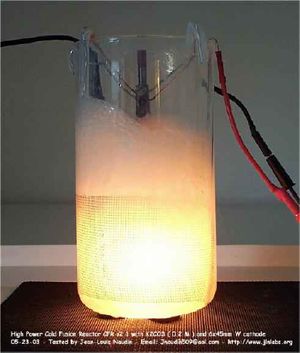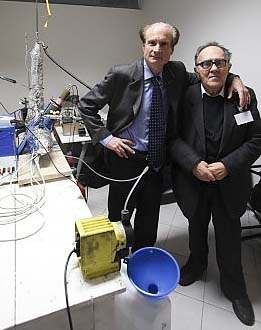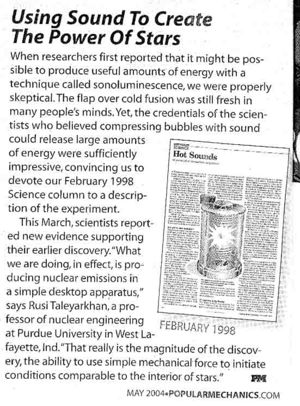Cold Fusion
Cold Fusion is a term used for controlled nuclear transformations taking place outside of fusion reactors. Such processes are rare and not useful for producing noteworthy amounts of energy or relevant fusion products. It is known since 1978 that muons can trigger such fusion processes. But the amount of energy generated remains insufficient to enable a chain reaction. Theoretical considerations to muon-catalysed fusion processes were already done in the 1940s by F. C. Frank and Andrej Sacharov.[1]
Muon-catalysed fusion has no practical appliance.
Experiments of Friedrich Paneth and John Tandberg
The Austrian-born physicists Friedrich Adolf Paneth and Kurt Peters worked in the twenties of the 20th century on the question of a possible nuclear fusion at low temperatures. Their idea was to fuse hydrogen into helium. Helium was very much in demand since it was needed for airships, but there was an import ban on it since the First World war.
In 1926 Paneth reported of a fusion of hydrogen into Helium using Palladium. During treatment of palladium with hydrogen he measured after light heating an unexplainable amount of helium.[2][3] In 1927 sources of errors in the experiment were recognized. It became evident that glass had a higher permeability for helium when heated. The helium was from the environment and not a fusion product. Paneth and Peters retracted their publication.[4][5][6]
The Swedish Physicist John Tandberg (1896 - 1968) from Lund was denied in 1927 patents on a cold fusion. Tanddberg tried to realize cold fusion under high pressure in an electrolysis cell with palladium.
Dem schwedischen Physiker John Tandberg (1896 - 1968) aus Lund wurden 1927 Patente zu einer kalten Fusion verweigert. Tandberg versuchte kalte Fusion unter hohem Druck in einer Elektrolysezelle mit Palladium zu realisieren.
Fleischmann and Pons 1989
In 1989, researchers Martin Fleischmann and Stanley Pons claimed to have accomplished cold fusion through an electrochemical process and received wide press coverage which led to a popularization of the term. Hopes for a sensational new energy source were fuelled. The Fleischmann-Pons-experiment showed a small energy release but could not be replicated. Even the authors later were unable to reproduce their experiment successfully. In this experiment hydrogen should have been fused through electrolysis of an electrolyte at the surface of two palladium electrodes. Basically, this should have produced energy from water.[7]
Rossi-Energy-Catalyzer / Piantelli-Focardi-Rossi-Experiments
The Focardi-Rossi Energy-Catalyzer is an alleged compact fusion reactor based on an assumed Cold Fusion technology which is planned to be brought to market by the Italian company EON Srl in 2011. While allegedly using no more than several hundred Watts in electrical heating energy, it is said to emit a heat output capacity of more than 10 kW. According to Italian inventors Sergio Focardi and Andrea Rossi, cold fusion of hydrogen and nickel was taking place in the reactor, leading to the formation of copper. As a side-effect of the reaction, ionizing radiation is said to be emitted, which was disproved by independent parties. So far, attempts to replicate the experiment independently failed. The latest (partially public) presentations took place from mid-January to end of March 2011.
Aqua Flame
Aqua Flame is a fusion project of the German company Purratio AG. Since Purratio refers to deuterium and palladium, it seems to be an application of the failed experiments of Fleischmann and Pons (1989).
Zirconium fusion reactor of Bolotov
The Zirconium fusion reactor of Bolotov is an alleged fusion reactor of the Ukrainian universal genius Boris Bolotov. He claims that his reactor is able to "transmute" the element Zirconium to Iridium and Palladium. With an input of 5 kW electrical energy an electric arc is said to enable "cold fusion" which would lead to an emission of thermal output of 200 kW. Replication experiments by independent parties are not known.
CETI Patterson Power Cell
Die CETI Patterson Power Cell is an alleged "cold fusion" - reactor of the U.S. physicist James Patterson. Thousands of small plastic beads coated with thin film layers of nickel and palladium are surrounded by a solution of a conductive salt in water through which an electric current is run. In consequence fusion processes are claimed to release heat.
Further Methods
Further methods are:
- Pyrofusion (without practical relevance)
- Sonofusion (or Bubble fusion, obviously data falsification)
Biological Transmutation
Biological Transmutation is hypothetically defined as a nuclear transmutation occurring in a living organism. There is no proof for the existence of such transformations.
Versions of this article in other languages
- Deutsch: Kalte Fusion
References
- ↑ Muon-catalyzed fusion in Wikipedia
- ↑ F. Paneth, Kurt Peters. Über die Verwandlung von Wasserstoff in Helium. Berichte der deutschen chemischen Gesellschaft. Berlin, Band=59, 1926. Seiten=2039–2048. DOI=10.1002/cber.19260590860. ISSN=0365-9488
- ↑ The Reported Conversion of Hydrogen into Helium. Nature, London. Issue=118, Number 2971. 1926, Pages=526–527. DOI=10.1038/118526a0|ISSN=0028-0836
- ↑ U.S. Department of Energy (1989). A Report of the Energy Research Advisory Board to the United States Department of Energy. Washington, DC: U.S. Department of Energy. Retrieved 2008-05-25
- ↑ F. Paneth, K. Peters, P. Günther. Über die Verwandlung von Wasserstoff in Helium. Berichte der deutschen chemischen Gesellschaft. Band 60, Berlin, 1926. Seiten=808–809. DOI=10.1002/cber.19270600336. ISSN=0365-9488
- ↑ Fritz Paneth: The Transmutation of Hydrogen into Helium. Nature. 119, 3002. 1927. Seiten=706–707. DOI=10.1038/119706a0. ISSN=0028-0836
- ↑ Browne, M. (May 3, 1989), "Physicists Debunk Claim Of a New Kind of Fusion", New York Times, accessed 2011-05-10



